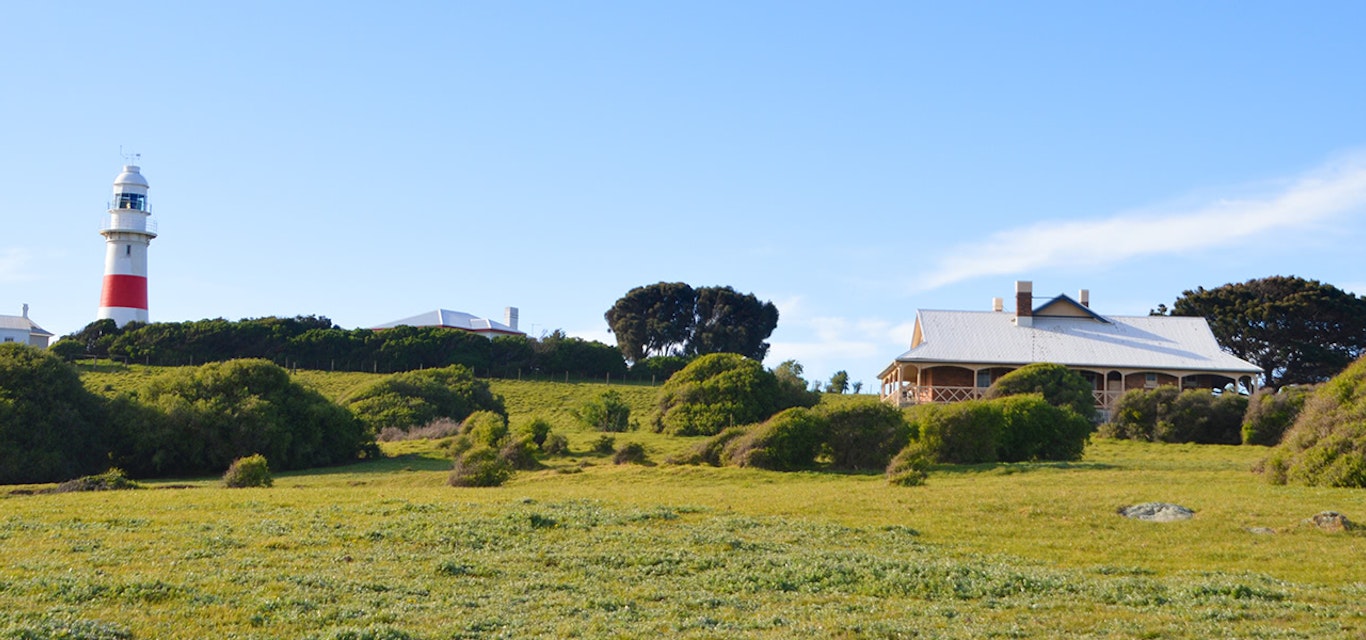Discovering Low Head
What exactly is a pilot station? And where on earth is Low Head? These were my first questions when heading off for a mid-week break.
Low Head is 50 kilometres north of Launceston – the pointy end of the mouth of the Tamar River. The First Peoples of this land, the Stoney Creek Nation, call the river kanamaluka. Low Head has a scattering of homes on a narrow strip of land with coastal vistas either side. As holiday homes drift away, the Pilot and Signal Station come into view but right now, we’re looking for the Queenslander. Nestled beneath the lighthouse, the Queenslander, part of Low Head Pilot Station Cottages, is a historic, four-bedroom home with a full wrap-around veranda taking in 360 degree views.
Caretakers, Chris and Jordan, have prepared a superb afternoon tea, reminiscent of great aunts and dainty teacups. Pork pies, sandwiches, Devonshire tea, custard tarts, soft sponges filled with fresh cream and blueberries – and champagne. We take tea on the veranda, with its unbroken views to the lighthouse, penguin rookery and Greens Beach on the west side of the Tamar. Around the other side are distant hills and the sweeping curve of East Beach. The house is surrounded by grasslands gently undulating from beach to lighthouse and down to the rocky coastline.
The lighthouse is the third oldest light station in the Commonwealth and has been fully operational since 1833. The crisp white tower dons a big red stripe, like a carefully wrapped gift. Outbuildings house one of the last two operational fog horns in Australia. It’s sunny and as Tasmanians know, sun must be appreciated. Who knows what tomorrow might hold? We spend a happy hour exploring rocks covered in orange lichen and listening to waves crash out over Bass Strait. I search for tell-tale signs of a whale. I can’t see one.
We meander around the headland, soaking up the solitude and ocean sounds. As dusk descends we’re hoping for a spectacular sunset from the veranda but alas, cloud build-up hides a colourful end to the day.
In the morning, sunrise bursts forth with a ton of colour. A rainbow of pinks, blues, purples and orange over the sparkling ocean.
As colours melt into clear skies we head back to cook up the feast in our breakfast basket – fat sausages, fresh eggs, bacon, muffins, bread with jam and butter and apple juice. With full bellies we watch clear skies turn grey and decide to spend our wet, windy day learning about pilot and signal stations.
Navigating the Tamar is dangerous and complicated. Pilot boats pull alongside ships so the pilot can board and steer vessels through treacherous waters. The Low Head Pilot Station commenced in 1805 and convict-built cottages, the oldest group of pilot buildings in Australia, were built around 1807. It’s dripping with maritime history.
The historical precinct, owned by the Tasmania Parks and Wildlife Service, has eight self-contained cottages, the Maritime Museum and Coxswains Café, as well as the lighthouse and Queenslander one kilometre away.
We take the short drive to the summit of Mt George with spectacular views across the river. The lookout houses one of four signal stations, which relayed messages between Launceston and Low Head. This one is a semaphore – a telegraphy system to send information with flags or fans. When in position they convey a code to signify a name, phrase or instruction.
As rain and wind descends we cross the Batman Bridge and drive down the western side of the Tamar, discovering pretty towns along the bumpy country road. We buy lunch at Gravelly Beach and discover Rivergrass Café. Wow. The pies are spectacular.
Along the Tamar Valley wine route is Marion’s Vineyard with its delicious views and hospitable owner, Marion. A native Cypriot, she and her husband established the vineyard 40 years ago. Mementos surround the tasting area and we leave with a beautiful bottle of wine. On our way back we travel via Beaconsfield, discovering Boot Hill – a tree festooned with tiny toddler tennis shoes and big blokes’ boots, all guarded by three pretty roosters. It’s half an hour back to our appointment at the Maritime Museum and as is often the case in Tasmania, there’s a personal connection – Des used to run with my dad and uncle. I could write a whole article about everything Des knows – pilotage, telegraphy, shipwrecks and giant wooden toolboxes. The museum brims with artefacts and memories.
Tonight’s sunset is golden light dipping below the horizon. Once the light dips it’s a short walk to Dotterel Point and the Low Head Penguin Tour. This is what I’m excited about.
Shirley and Abbey take us to the beach. These girls know their penguins. Did you know there are 3000-5000 penguins living in the headland? Their little 5cm legs and backward knees make the waddle from shoreline to nest a difficult trek, so they stop frequently for a ‘coffee break’. Orange torches light them up as they head home. We spend 45 minutes immersed in penguin lifestyle and see hundreds of penguins waddling, preening and singing. We even see Alfred heading the 1.5km back to his nest, momentarily resting under the office.
The final sunrise from the veranda is golden and magnificent, shining over commercial shipping vessels and modern day pilot boats. We walk around the headland, taking in the array of colours one last time while I spend a moment scanning Bass Strait for a whale. I still can’t see one. Maybe next time.
Simone was the winner of our recent travel writing competition. We'd love to do more of these competitions in the future. Keep an eye out if you'd like to enter and you could be writing for us next!
